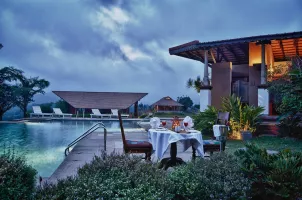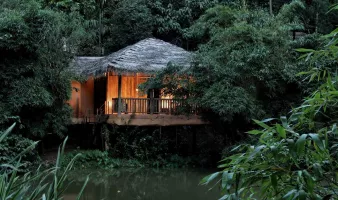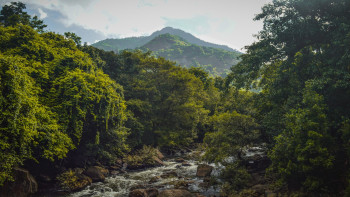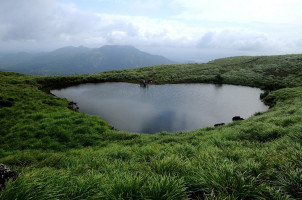Wayanad Wildlife Sanctuary Travel Guide
Wayanad Wildlife Sanctuary is a haven for nature lovers and wildlife enthusiasts, located in the Western Ghats of Kerala, India. This sanctuary is renowned for its rich biodiversity, comprising a variety of flora and fauna. Established in 1973, it covers an area of 344 square kilometers and is home to rare species like the Indian Elephant and the Royal Bengal Tiger. The sanctuary's lush greenery, tranquil environment, and stunning landscapes make it a popular eco-tourism destination in India.Top Attractions in Wayanad Wildlife Sanctuary
- Jungle Safari
- Elephant Sighting
- Trekking in the Western Ghats
- Boating in Pookode Lake
- Visit to Thirunelli Temple
Wayanad Wildlife Sanctuary is Famous for
Its diverse wildlife, lush green forests, and picturesque landscapes make it famous among nature lovers and wildlife enthusiasts.Top Attractions in Wayanad Wildlife Sanctuary
- Exploring the Edakkal Caves
- Wildlife Safari in Muthanga Wildlife Sanctuary
- Chembra Peak Trekking
- Banasura Sagar Dam Visit
- Meenmutty Waterfalls Adventure
What's Great about Travelling to Wayanad Wildlife Sanctuary?
- Perfect destination for nature lovers
- Opportunity to spot rare wildlife species
- Tranquil and serene environment
- Great for eco-tourism enthusiasts
What's Not So Great about Travelling to Wayanad Wildlife Sanctuary?
- Not ideal for those seeking a bustling city experience
- Limited accommodation options inside the sanctuary
- Weather can be unpredictable during monsoon season
Travel Tips for Wayanad Wildlife Sanctuary
- Carry insect repellent and sunscreen
- Respect the wildlife and follow the rules of the sanctuary
- Book safari or trekking activities in advance
- Stay hydrated during treks and safaris
Important Wayanad Wildlife Sanctuary trip information
- Ideal Duration: 2-3 days
- Best Time to Visit: October to May
- Nearby Airports and Railway Stations: Calicut International Airport and Kozhikode Railway Station
Per Person
14,400
*EXCLUDING APPLICABLE TAXES Per Person
32,600
*EXCLUDING APPLICABLE TAXES 4.3 Ratings
( 389 Reviews )
( 389 Reviews )
Per Person
10,700
*EXCLUDING APPLICABLE TAXES 4.3 Ratings
( 389 Reviews )
( 389 Reviews )
Per Person
12,200
*EXCLUDING APPLICABLE TAXES Per Person
10,500
*EXCLUDING APPLICABLE TAXES 4.2 Ratings
( 41 Reviews )
( 41 Reviews )
Per Person
11,000
*EXCLUDING APPLICABLE TAXES FAQ's on Wayanad Wildlife Sanctuary
Q1: What is the best time to visit Wayanad Wildlife Sanctuary?
The best time to visit Wayanad Wildlife Sanctuary is from October to May when the weather is pleasant, and wildlife sightings are more frequent. Avoid the monsoon season from June to September as heavy rainfall can disrupt travel plans and wildlife viewing opportunities.
Q2: Do I need a visa to travel to Wayanad Wildlife Sanctuary?
Travelers to Wayanad Wildlife Sanctuary, located in India, may need a tourist visa. Check with the nearest Indian embassy or consulate for specific visa requirements based on your nationality. Some countries may have visa exemptions or visa-on-arrival options for short visits.
Q3: What are the must-visit attractions in Wayanad Wildlife Sanctuary?
Must-visit attractions in Wayanad Wildlife Sanctuary include the Tholpetty Wildlife Sanctuary, Muthanga Wildlife Sanctuary, Edakkal Caves, and Banasura Sagar Dam. Nature lovers can also explore Chembra Peak and Soochipara Waterfalls for breathtaking views.
Q4: Is Wayanad Wildlife Sanctuary a safe place to travel?
Wayanad Wildlife Sanctuary is generally safe for tourists. However, it is advisable to follow safety precautions, including staying on designated paths during wildlife safaris and avoiding confrontations with wild animals. Be cautious while trekking or exploring remote areas.
Q5: What is the local currency in Wayanad Wildlife Sanctuary and can I use credit cards?
The local currency in Wayanad Wildlife Sanctuary is the Indian Rupee (INR). While major establishments may accept credit cards, it is recommended to carry cash for smaller shops and local vendors. ATMs are available in towns for convenient cash withdrawals.
Q6: What is the local cuisine like in Wayanad Wildlife Sanctuary?
The local cuisine in Wayanad Wildlife Sanctuary offers a variety of flavors with dishes like Malabar biryani, appam with stew, and seafood delicacies. Vegetarians can enjoy dishes like avial and olan. Don't miss trying local teas and snacks like banana chips and Kerala-style coffee.
Q7: What transportation options are available in Wayanad Wildlife Sanctuary?
Transportation options in Wayanad Wildlife Sanctuary include buses, taxis, and rental cars. Public buses connect major towns, while taxis and rental services offer flexibility for exploring the sanctuary and nearby attractions. Private vehicles or guided tours are recommended for wildlife safaris.
Q8: Are there any cultural norms or etiquette I should be aware of when visiting Wayanad Wildlife Sanctuary?
When visiting Wayanad Wildlife Sanctuary, it is important to respect local customs. Dress modestly, especially when visiting religious sites. Avoid public displays of affection and ask for permission before taking photographs of locals. Respect wildlife and natural habitats by following designated trails and guidelines set by park authorities.
Q9: I am a travel agent. How can I buy travel leads of Wayanad Wildlife Sanctuary?
Register yourself as a travel agent at agents.tripclap.com and then you can buy travel leads to Wayanad Wildlife Sanctuary once your account is approved. For more details contact our support team at +91-8069186564 or support@tripclap.com






